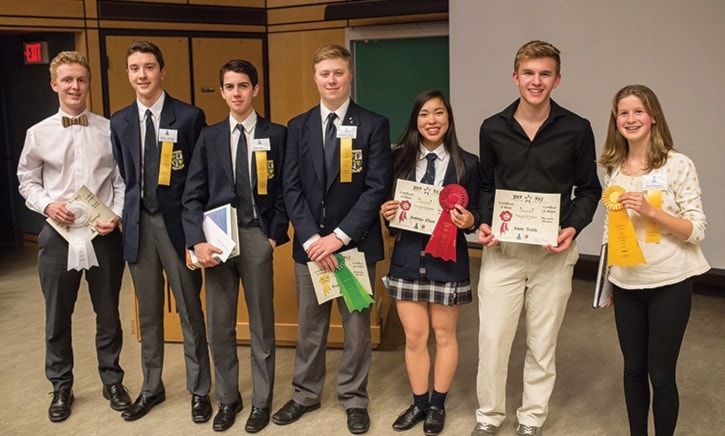Saanich scientist Nathan Kuehne’s mission to make life easier for those suffering from a rare condition earned him the top prize at the Vancouver Island Science Fair last week.
The 17-year-old Grade 11 student at Glenlyon Norfolk School is now taking his project, a home-diagnostic for the rare condition – officially known as a Phenylalanine Self-Diagnostic Test for Phenylketonuria (PKU) Patients – to compete in the Canada Wide Science Fair in Fredericton, NB, from May 10 to 16. It’s a return to the Canada Wide Science Fair for Kuehne, who earned a gold medal and three other awards there last year, when he presented a Supramolecular-Enhanced Fluorescence for Early Cancer Detection.

“The idea for last year’s project was a home-test to diagnose tumour-based cancer,” said Kuehne, who lives near Cadboro Bay. “This year’s project was going to be based off last year’s project, to further develop the urine test for tumour based cancers,” he said. “The goal was to be able to place a urine sample into a tester and judge if you had cancer or not.”
As Kuehne worked on it he ran into some challenges. When he tried it with phenylalanine, it worked better, he said. “Once I was able to confirm the same research was working for PKU, I discovered there’s a need for that type of test.”
Phenylketonuria is a rare, inherited genetic disorder that affects about one in 12,000 to 15,000 babies born in North America. Managing PKU requires ongoing analysis of blood phenylalanine, a naturally occurring amino acid that people with PKU fail to process. It builds up and causes health problems, including neurologic symptoms.
The condition is managed through blood monitoring, and in 2013 the National PKU Alliance issued a challenge for an at-home test, unbeknownst to Kuehne, who began creating something similar. NPKUA’s challenge has since closed, but Kuehne is in contact with NPKUA’s head scientist about the next step in bringing the phenylalanine monitor to life.
“PKU would be diagnosed at birth, so this test would be used to monitor the level of phenylalanine throughout the person’s life after diagnosis,” said Erin Dallin, co-head of science at GNS who has helped Kuehne the past three years. “The idea is that it could be used daily, or as directed by a physician to ensure that the diet is being adequately adhered to.”
In addition to winning the 2015 Island Science Fair overall award, Kuehne was in Vancouver last week where he finished second at the 2015 Sanofi Biogenius B.C. competition, which focuses on science research projects in the area of biotechnology.
“GNS has provided a huge amount of support for my science fair projects, and I’m grateful to the University of Victoria chemistry department,” Kuehne said. “It’s good to get the challenge outside of school work, I enjoy it.”
Kuehne is one of the hardest-working students Dallin has had the pleasure of working with, she said.
“This project has been entirely driven by him, he’s devoted much of his spare time (including the summer) to achieve at this level.”
The work is at a university level, added Dallin, and has the potential for publication in a peer-reviewed journal, a rarity for a high school student.
“I feel very fortunate that I have been able to be involved in this research and the progression I have seen in Nathan’s abilities. I have seen him ask questions and design experiments that many undergraduate students would find challenging,” she said.
Saanich students excel at Island Science Fair
While the overall winner was Nathan Kuehne (Glenlyon-Norfolk) for his Phenylalanine Self-Diagnostic Test, the Saanich duo of Andrea Chan (St. Michaels University School) and Matt Treble (Lambrick Park secondary) won second for their project, Prosthetic Hand Grip Using 3D Printable Compounds.
Lambrick's Austin Sawyer Lambrick Park was third for his low-cost solutions to increase the longevity of wood railroad ties.
"It was pretty simple, something overlooked, you just wrap a zap tag around the ends of the ties. It comforts them so they can't expand and crack when they freeze."
Fourth place went to Alexander Stead and David Weaver (both Glenlyon-Nofolk) for Iron Nanoparticle Based In-Situ Anti-Coagulant Delivery.
In fifth was Grade 8 Janet Dawson of Gordon Head middle school (who is coached by Austin Sawyer) for accurately predicting within five minutes where the sun will set from the top of Mount Douglas (PKOLS).
All seven students advance to the Canada-Wide Science Fair (CWSF) in New Brunswick in May. There they will join 500 students from across the country for a week of competition and science education.
reporter@saanichnews.com
